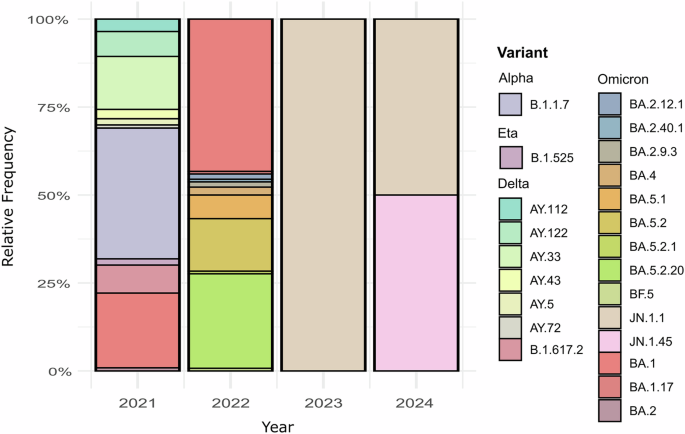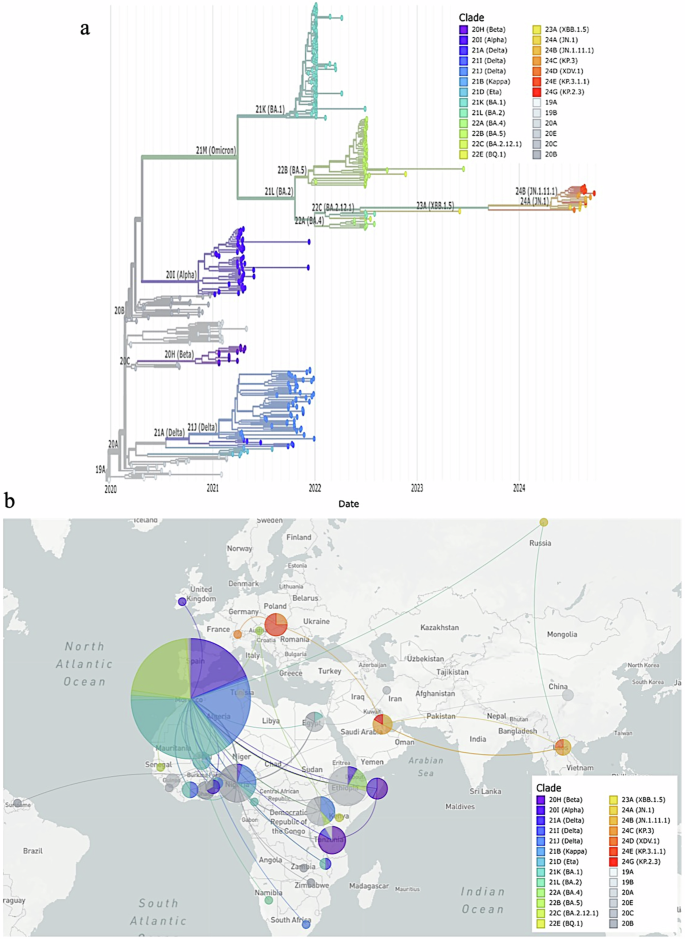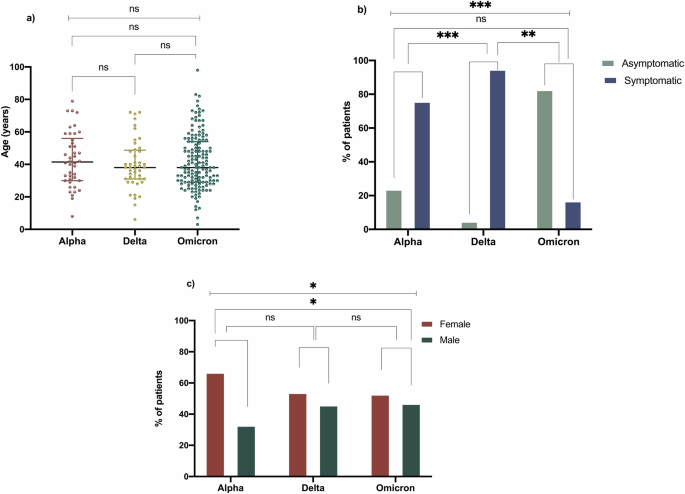Demographic and clinical characteristics
In our cohort of 235 SARS-CoV-2-positive patients, a female predominance was observed, with 56.6% (n = 133) females and 43.4% (n = 102) males. The age distribution showed that 48.5% (n = 114) of patients were between 20–40 years old, 31.5% (n = 74) were aged 41–60 years, 14.5% (n = 34) were over 60 years, and 5.5% (n = 13) were under 20 years. The majority of cases were symptomatic (79.1%, n = 186), while 14.5% (n = 34) were asymptomatic; symptom status was unavailable for 6.4% (n = 15) of patients (Table 1).
A comparative analysis of SARS-CoV-2 variants based on demographic characteristics and disease presentation was performed (Fig. 1). No significant differences in age distribution were observed across the variants (Fig. 1a; overall p = 0.903): Alpha vs. Delta (p = 0.697), Alpha vs. Omicron (p = 0.935), and Delta vs. Omicron (p = 0.786). Notably, Delta cases were significantly more symptomatic than Alpha (p = 0.0001) or Omicron (p = 0.007) cases, whereas the difference in symptomatology between Alpha and Omicron was not significant (p = 0.220) (Fig. 1b). Regarding sex distribution, no significant differences were observed between Alpha and Delta (p = 0.060) or Delta and Omicron (p > 0.999); however, a significant difference was found between Alpha and Omicron (p = 0.043), and the overall comparison among all three variants was significant (p = 0.044) (Fig. 1c).
a Age distribution. b Proportion of symptomatic versus asymptomatic cases. c Sex distribution. Statistical comparisons between variant groups were performed using appropriate tests. Statistical significance is indicated as follows: ns (p > 0.05), *(p ≤ 0.05), **(p ≤ 0.01), ***(p ≤ 0.001).
Variant distribution and temporal dynamics
Sequencing data revealed distinct shifts in variant prevalence from 2021 to 2024 (Table 2). In 2021, Alpha (B.1.1.7, 37.5%, n = 42/112) and Delta (B.1.617.2, 39.2%, n = 44/112) dominated, with minor circulation of Eta (B.1.525, 1.8%, n = 2/112) and an already notable presence of early Omicron (B.1.1.529, 21.4%. n = 24/112). Omicron and its sub-lineages fully replaced all other variants, accounting for 100% of cases in 2022, 2023, and 2024, and maintained complete dominance throughout this period.
Figure 2 illustrates this transition: 2021 exhibited high variant diversity, BA.1.17 (Alpha variant), AY.33 (Delta sub-lineage) and BA.1 (Omicron sub-lineage), while 2022 saw consolidation into BA.2, BA.5.1, and BA.5.2 Omicron sub-lineages. In 2023, a single Omicron sub-lineage (JN.1.1) predominated, followed by the emergence of JN.1.45 (Omicron sub-lineage) in 2024, which rapidly displaced earlier variants.

Evolution and replacement of SARS-CoV-2 variants in Morocco between 2021 and 2024, with emergence and dominance of specific lineages each year.
Mutation accumulation and immune evasion
Delta (AY.112, AY.122) and Alpha variants in 2021 carried modest genetic changes (34–38 amino acid substitutions, 4–4 deletions). Omicron BA.1 (2022) showed marked complexity (44 substitutions, 16 deletions), the lineages derived from BA.2 and BA.5 showed a high mutational load, with BA.2.9.3 exhibiting 54 amino acid substitutions and BA.5.1 15 deletions, underlining their significant genetic divergence within Omicron. By 2024, JN.1.1 and JN.1.45 dominated, exhibiting unprecedented mutational loads (88–89 substitutions, 17 deletions) (Table 3), correlating with enhanced immune evasion and transmissibility.
Phylogeographic and evolutionary analysis
Phylogenetic reconstruction revealed distinct evolutionary patterns across the study period (Fig. 3a, b). In 2021, the Alpha (20I) and Delta (21A/J) variants showed limited global connectivity, with short phylogenetic branches indicative of predominantly localized transmission within Morocco. The emergence of Omicron in late 2021 and its sustained circulation through 2022–2023 marked a significant shift. Sub-lineages BA.1, BA.2, and BA.5 exhibited long branch lengths and high divergence in phylogenetic analyses, reflecting both rapid viral evolution and extensive international spread across multiple continents, including Europe, Sub-Saharan Africa, and Asia. By 2024, the JN.1.45 sub-lineage had formed a distinct phylogenetic clade, demonstrating adaptive radiation likely driven by immune selection pressures.

a Maximum-likelihood phylogenetic tree of Moroccan sequences contextualized within global variants of concern. b Inferred international transmission pathways of major variants, with arrow thickness proportional to introduction frequency.
Migration pattern analysis (Fig. 3b) revealed multiple bidirectional viral exchanges between Morocco and other international regions, particularly during the Omicron wave.
